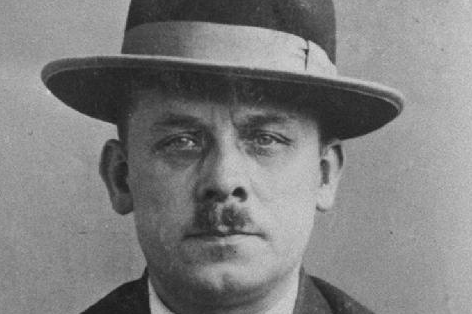
Friedrich Heinrich Karl "Fritz" Haarmann (October 25, 1879 – April 15, 1925), also known as the Butcher of Hanover and the Vampire of Hanover was a German serial killer who is believed to have been responsible for the murder of 27 boys and young men between 1918 and 1924. He was convicted, found guilty of 24 murders and executed.


Background information
Birth name Friedrich Heinrich Karl Haarmann
Also known as The Butcher of Hanover,
The Vampire of Hanover
Born (1879-10-25)October 25, 1879
Hanover, German Empire
Died April 15, 1925(1925-04-15) (aged 45)
Cause of death Decapitation by guillotine
Conviction Murder
Sentence Death
Killings
Number of victims 24-27+
Country Germany
State(s) Province of Hanover, Prussia
Date apprehended June 22, 1924
Early lifeFritz Haarmann was born in Hanover in 1879, the sixth child of poor parents. Haarmann was a quiet child who shunned many boys' activities such as sports and preferred to play with his sisters' toys. He was also a poor student. At the age of 16, at the urging of his parents, Haarmann enrolled in a military academy at Neu Breisach. He initially adapted to military life, and performed well as a trainee soldier. After just one year in the academy, however, he began to suffer seizures and was discharged for medical reasons.
Haarmann returned to Hanover and took employment in a cigar factory. He was arrested in 1898 for molesting children, but a psychologist declared Haarmann was mentally unfit to stand trial, and he was sent to a mental institution indefinitely. Six months later, Haarmann escaped and fled to Switzerland, where he worked for two years before he returned to Germany. He again enlisted in the military, this time under an alias, but in 1902, he was again discharged under medical terms. He was awarded a full military pension and returned to live with his family and took employment in the small business his father had established. After an argument with his father, Ollie, led to a violent fight between them, Haarmann was arrested, charged with assault and again sent for psychiatric evaluation. This time, a doctor did not diagnose Haarmann as mentally unstable. A court discharged Haarmann and he again returned to live with his family. Shortly afterwards, Haarmann attempted to open a small shop, but the business soon went bankrupt.
Criminal careeR
For the next decade, Haarmann lived as a petty thief, burglar and con artist. He was frequently arrested and served several short prison sentences. He gradually began to establish a relationship with Hanover police as an informer, largely as a means of redirecting the attention of the police from himself, and later admitted that the police began to view him as a reliable source of information regarding Hanover's criminal network.
In 1914, Haarmann was convicted of a series of thefts and frauds and was imprisoned just as World War I began. Upon his release in 1918, he was struck by the poverty of the German nation as a result of the loss the nation had suffered in World War I. The country was bankrupt. Fritz Haarmann immediately reverted to the criminal life he had lived before he was arrested in 1914. The new state of Germany provided him with even more opportunities to operate on the fringes of the criminal network, and because of the increase in crime as a result of the poverty the nation was enduring, police again began to rely on Haarmann as an informer.
Murders
Detectives search a stove inside Haarmann's roomBetween 1918 and 1924, Haarmann committed at least 24 murders, although he is suspected of murdering a minimum of 27. Haarmann's first known victim was a 17-year-old youth named Friedel Rothe. When Rothe disappeared in September 1918, his friends told police he was last seen with Haarmann. Under pressure from Rothe's family, police raided Haarmann's apartment, where they found their informer in the company of a semi-naked teenage boy. They charged Haarmann with sexual assault, and he was sentenced to nine months imprisonment. Haarmann avoided serving his sentence throughout 1919, and during this time, met a young runaway named Hans Grans, who was subsequently to become his lover.
Haarmann served his 9-month imprisonment between March and December 1920. Again, he regained the trust of the police and became an informer. Shortly after his release, Haarmann moved into a new apartment: number 27 Cellerstraße.Shortly afterwards, Hans Grans moved into Haarmann's apartment.
Detectives point towards the entrance to Haarmann's roomHaarmann's subsequent victims largely consisted of young male commuters, runaways and, occasionally, male prostitutes whom he would typically encounter around Hanover's central railway station. The victims would be lured back to his apartment and then killed by being bitten through their throats, sometimes as they were sodomized. All of Haarmann's victims were dismembered before they were discarded, usually in the Leine River. The possessions of several victims were either sold on the black market or retained by either Haarmann or his younger lover, Hans Grans. Rumor also had it that Haarmann would peddle meat from the bodies of his victims as canned black market pork. Although no physical evidence was ever produced to confirm this, Haarmann was known to be an active trader in contraband meat.
Haarmann's accomplice and live-in partner, Hans Grans, sold the possessions of several of the victims cheaply on the black market, and kept other possessions for himself. Haarmann initially claimed that although Grans knew of many of his murders, and personally urged him to kill two of the victims so he could obtain their clothing and personal possessions, he was otherwise not involved.
Police photo of Haarmann's roomHaarmann was eventually apprehended when numerous skeletal remains, which he had dumped into the Leine River, washed up downstream in May and June 1924. The police decided to drag the river and discovered more than 500 human bones which were later confirmed as having come from at least 22 separate human individuals. Suspicion quickly fell upon Haarmann, who had convictions for molesting children and had been connected to the disappearance of Friedel Rothe in 1918. Haarmann was placed under surveillance and on the night of June 22, was observed prowling Hanover's central station. He was quickly arrested after trying to lure a boy to his apartment. His apartment was searched and the walls were found to be heavily bloodstained. Haarmann tried to explain this as a by-product of his illegal trade as a butcher. However, clothing and personal items known to be possessions of several missing youths were also found in his home. Under interrogation, Haarmann quickly confessed to raping, killing and butchering young men since 1918. When asked how many he had killed, Haarmann claimed "somewhere between 50 and 70". The police, however, could only connect Haarmann with the disappearance of 27 youths, and he was charged with 27 murders. It is interesting to note that only a quarter of the personal items found in his apartment were identified as having belonged to any of the victims.
Trial
Fritz Haarmann being led into court in December 1924Fritz Haarmann's trial began on December 4, 1924. Haarmann was charged with the murder of 27 boys and young men who had disappeared between 1918 and June that year. The trial was spectacular; it was one of the first major modern media events in Germany. The term "serial killer" had not yet been coined, and the public and press were at a loss for words to describe the case; Haarmann was simultaneously referred to as the "werewolf", a "vampire", and "The Wolf Man". Apart from the cruelty of what Haarmann had admittedly done, even more scandalous - shaking German society to the core - was the involvement of the police in the case: Haarmann was a police informant who frequently gave up other criminals to investigators. Until Haarmann was arrested, it had never occurred to police that the serial killer they were looking for had been working right under their nose, even though some of the victims were last seen in his company.
Haarmann (seated in front of chalkboard sketch of his apartment), during his trial in 1924 The trial lasted barely two weeks. On December 19, 1924, Haarmann was found guilty of 24 of the 27 murders and sentenced to death. He was acquitted of three murders which he denied, even though the personal possessions of the boys were either in his possession or acquaintances of his at the time of his arrest. Haarmann made no appeal against the verdict.
Haarmann was beheaded by guillotine on April 15, 1925. His last words before he was beheaded were: "I repent, but I do not fear death."
Aftermath
The communal grave of Haarmann's victimsHans Grans was initially found guilty of enticement to murder in the case of Adolf Hannappel, a 17-year-old apprentice carpenter who vanished from Hanover's railroad station on November 11, 1923. Witnesses had seen Grans, in the company of Haarmann, pointing to Hannappel. Haarmann claimed this was one of two murders committed upon the insistence of Grans and for this reason, Grans was sentenced to death. The discovery of a letter from Haarmann declaring Grans' innocence later led to a second trial and a 12-year prison sentence for Grans. After serving his sentence, Hans Grans continued to live in Hanover until his death in 1975.
The remains of Haarmann's victims were buried together in a communal grave in Stöckener Cemetery in February 1925. In April 1928, a large granite memorial in the form of a triptych, inscribed with the names and ages of the victims, was erected over the communal grave.
After his execution, Haarmann's head was preserved in a jar by scientists to examine the structure of his brain. Haarmann's head is now kept at the Göttingen medical school.
The case stirred much discussion in Germany about the death penalty, the correct approach towards mentally ill offenders, police investigation methods, and homosexuality
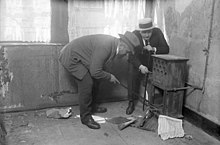
Detectives search a stove inside Haarmann's room

Detectives point towards the entrance to Haarmann's room
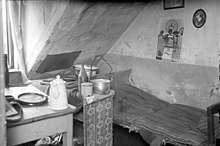
Police photo of Haarmann's room

Fritz Haarmann being led into court in December 1924
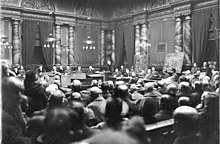
Haarmann (seated in front of chalkboard sketch of his apartment), during his trial in 1924
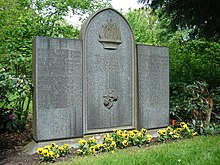
The communal grave of Haarmann's victims
VictimsName Age Date of disappearance Notes
Friedel Rothe 17 September 25, 1918 Haarmann claimed to have buried Rothe in Stöckener cemetery
Fritz Franke 17 February 12, 1923 Franke was originally from Berlin
Wilhelm Schulze 17 March 20, 1923 Schulze was an apprentice writer
Roland Huch 16 May 23, 1923 Student. Vanished from Hanover station
Hans Sonnenfeld 19 May, 1923 A runaway from the town of Limmer
Ernst Ehrenberg 13 June 25, 1923 Disappeared whilst running an errand for his parents
Heinrich Struß 18 August 24, 1923 Haarmann was in possession of Struß's violin case when arrested
Paul Bronischewski 17 September 24, 1923 Vanished on his way to visit his Uncle
Richard Gräf 17 September, 1923 Disappeared after telling his friends a detective from Hanover had found him a job
Wilhelm Erdner 16 October 12, 1923 Disappeared from Hanover station. Haarmann sold Erdner's bicycle
Hermann Wolf 15 October 24 or 25, 1923 The victim's clothes were traced to Haarmann and his acquaintances
Heinz Brinkmann 13 October 27, 1923 Vanished from Hanover station after missing his train home to Clausthal
Adolf Hannappel 17 November 11, 1923 An apprentice carpenter. Witnesses saw Haarmann approach Hannappel
Adolf Hennies 19 December 6, 1923 Hennies disappeared whilst looking for work in Hanover
Ernst Spiecker 17 January 5, 1924 Disappeared on his way to appear as a witness at a trial
Heinrich Koch 20 January 15, 1924 Koch was known to be an acquaintance of Haarmann
Willi Senger 19 February 2, 1924 The victim's clothes were found in Haarmann's apartment after his arrest
Hermann Speichert 16 February 8, 1924 An apprentice electrician
Alfred Hogrefe 16 April 6, 1924 An apprentice mechanic. All of Hogrefe's clothes were traced to Haarmann or Grans
Hermann Bock 22 April, 1924 Bock was last seen by his friends walking towards Haarmann's apartment
Wilhelm Apel 16 April 17, 1924 Disappeared on his way to work
Robert Witzel 18 April 26, 1924 Haarmann admitted dumping Witzel's remains in the Leine River
Heinrich Martin 14 May 9, 1924 An apprentice locksmith. Martin disappeared from Hanover station
Fritz Wittig 17 May 26, 1924 Haarmann insisted Grans ordered him to commit both this murder and the murder of Hannappel
Friedrich Abeling 10 May 26, 1924 The youngest victim. Remains dumped in the Leine River
Friedrich Koch 16 June 5, 1924 Vanished on his way to college. Koch was last seen in the company of Haarmann
Erich de Vries 17 June 14, 1924 Haarmann led police to Erich's remains after his arrest
In film
Poster of Fritz Lange's 1931 film MThe case of Fritz Haarmann has been the inspiration for at least three films. The classic film M, which starred Peter Lorre and was released in 1931 and directed by Fritz Lang was inspired by the crimes of Fritz Haarmann, as well as those of two other infamous German serial killers of the early twentieth century: Düsseldorf child killer Peter Kürten and Carl Großmann.
The film The Tenderness of the Wolves (Die Zärtlichkeit der Wölfe), released in July 1973, was directly based upon Haarmann's crimes. The film, directed by Ulli Lommel, written by and starring Kurt Raab as Haarmann. German film director Rainer Werner Fassbinder produced the film and also appeared in a minor role as Wittkowski.
The most recent film to be based upon Haarmann's murder spree, Der Totmacher (The Deathmaker), was released in 1995. This film starred Götz George as Haarmann. This film focuses on the records of the psychiatric examinations of Haarmann by Erich Schultze, one of the main psychiatric experts in the trial. The plot of Der Totmacher centers around Haarmann's interrogation after his arrest, as he is being interviewed by a court psychiatrist












